Expert Q&A: The Clients
Interview by Amy Nelson
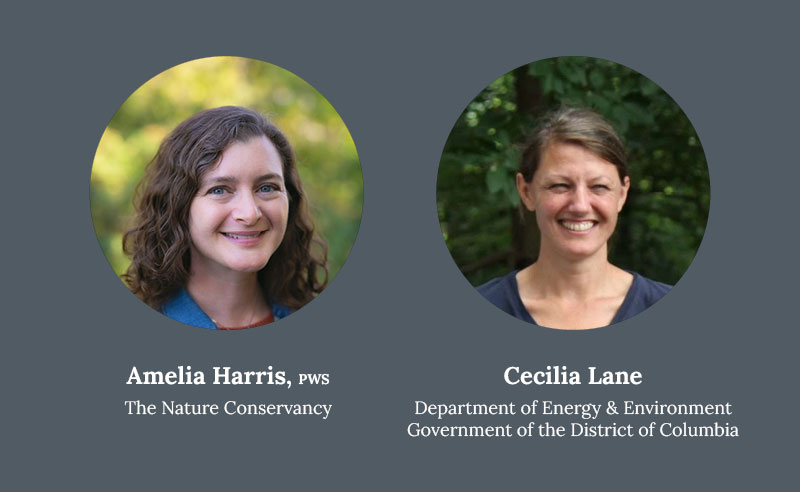
Amelia Harris is a Restoration Ecologist working with The Nature Conservancy’s Ohio Stream and Wetland Mitigation Program. She earned her Master of Science degree from the University of Tennessee at Chattanooga and is certified as a Professional Wetland Scientist. Cecilia Lane is an Environmental Protection Specialist with the District of Columbia’s Department of Energy & Environment. For the past seven years, she has worked on large scale upland retrofits and stream restoration projects in the District. Prior to coming to DOEE, Cecilia worked as the Stormwater Coordinator for the Chesapeake Stormwater Network where she helped define the rules of the road as it comes to Chesapeake Bay nutrient accounting.
Tell us about the kinds of challenges your organization/agency is addressing with nature-based solutions.
Cecilia: I work for the District’s [Washington, DC] Department of Energy and Environment in the Watershed Protection Division as an Environmental Protection Specialist. We work to mitigate the environmental challenges faced by DC’s urban landscape. Specifically, we work to address the complexities of stormwater runoff and habitat degradation in ultra-urban environments. Our primary goals are to improve water quality and enhance the overall health of the city’s ecosystems. I manage upland stormwater retrofits and downstream restoration efforts. Our highly built out, very dense environment provides a number of unique challenges; from lots of impervious cover to competition for open space where you would be able to do these kinds of projects.
Amelia: I work for The Nature Conservancy, which many people know as a global organization, but I am in Ohio in a unit that works specifically with our state’s Stream and Wetland In-lieu Fee Program. When developers impact a stream or wetland, paying into the state’s in-lieu fee program is one way that they can mitigate those impacts, which they need for their permit. Wherever those impacts are, that’s where our funding comes from, and those dollars stay in the impacted watershed. We work on a HUC 8 watershed system, and our task is to locate sites where we can build restoration projects to mitigate the stream and wetland impacts so that there is no net loss of surface water features, streams, and wetlands. We do this work all across the state.
What percentage of those projects are you currently executing using the design-build project delivery method?
Amelia: We have about 40 projects going on right now and 99% of them are design-build. I can only think of one current project that is a design-bid-build, and that’s a unique circumstance. We were able to purchase a very large property. Our funding comes in as impacts are made, so it’s not like we have a giant pot of money to spend, but we knew the site had great potential. We are not able to fund all of the restoration we want to do there right now (nor do we even know all of the restoration we want to do right now) so in this case, restoration will be done in a phased approach. We just don’t have all the details right now, so if we can get a design now and then bid out construction later, we just get more accurate numbers, and that is more efficient for everybody. Again, this is a unique case. For the most part, we are using design-build as our go-to contracting format.
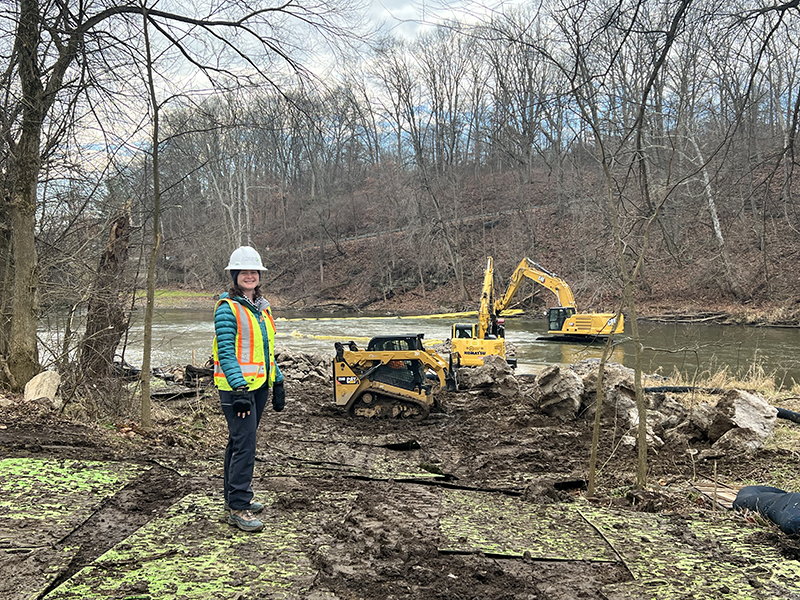
Cecilia: Typically, we aim to use a design-build approach for almost every project. That said, larger projects—such as many of our stream restorations that have significant permitting requirements—often require a more comprehensive design effort. They often need to be nearly 100% designed to fully get those permits. Those more detailed designs not only facilitate the permitting process, but they also ensure that the construction bids accurately reflect the true scope and complexity of the project. We really need that level of design to get a more accurate construction bid, and frankly, to make sure that those vendors fully understand what they’re signing up to do. Most of our large stream restoration projects are design-bid-build for that reason.
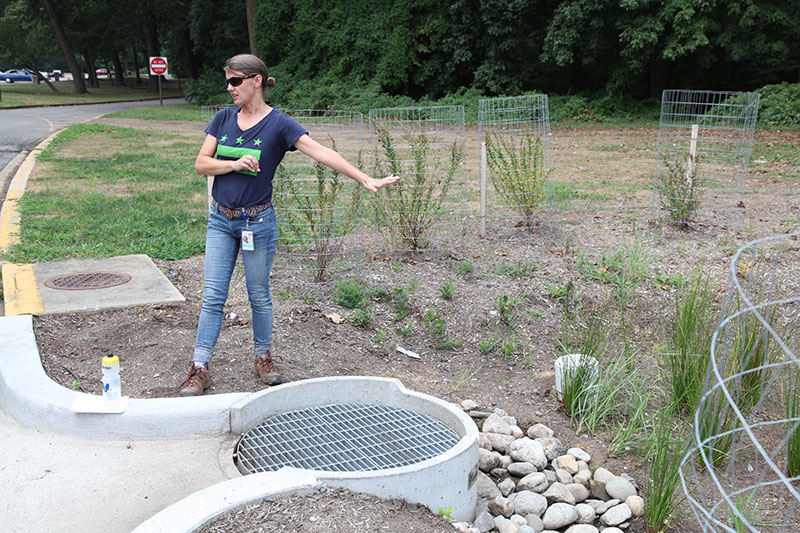
How do you decide which delivery method to use for your projects. Are there certain parameters that guide the decision on this or certain limitations due to the type of funding?
Amelia: Our program has been going for about 10 years, and we’ve been actively building projects for five of them. We are pretty new at this, and we are learning as we go along. In the beginning, we did a couple design-bid-build projects, and we learned from those experiences that design-bid-build generally wasn’t the best for us. They took a long time and they cost more in the long run.
Cecilia, were there other parameters that you haven’t mentioned that factor into decisions about how to approach the projects that you manage?
Cecilia: Generally, we try to pursue the design-build approach whenever possible, and when it makes sense. With the design-bid-build approach, procurement is one of our biggest time sucks—both the act of developing the solicitation, and then actually making it through procurement—especially for larger, more expensive projects that go through multiple rounds of internal and external review.
Design-build offers a faster mechanism for getting project implementation going, but we also recognize and value the integration of the design, construction, and post-construction or maintenance phases, for multiple reasons. Number one, it is great to have the designer engaged through every step of the project. There is a bit more buy-in. I feel like we get better projects as an outcome because the designers are invested in the success of this project from design through construction and maintenance, since they’re going to be responsible for addressing any challenges that arise from project implementation. I also feel that it provides us with a positive feedback loop for learning and application—in making any needed design or site adjustments for a particular project, we are able to avoid similar challenges in future project implementation.
I also feel that design-build provides us a lot more flexibility to design in a creative and responsive way, particularly in the District, where the moment you start digging, you run the risk of locating something underground that you did not design around. Having the flexibility to adaptively manage based on the geographic setting we’re dealing with is important. There are so many advantages to design-build.
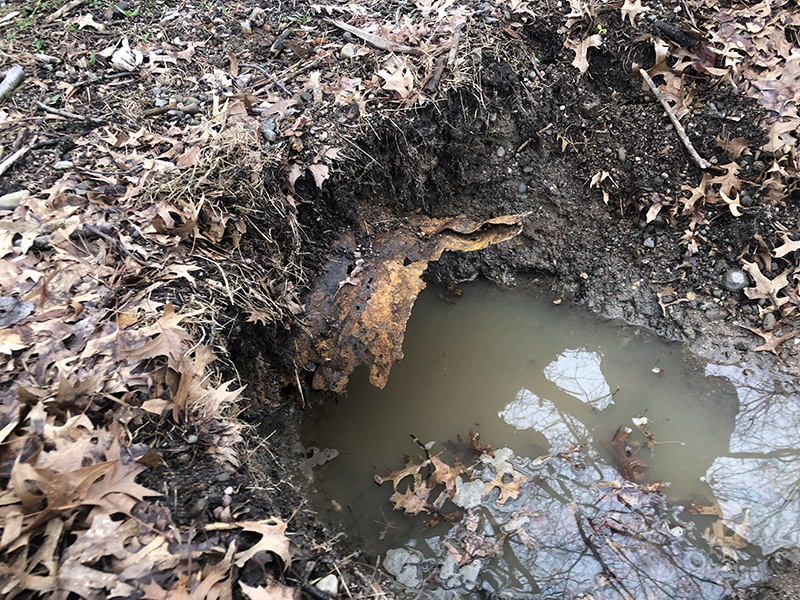
It really is just a more efficient approach
What other advantages, and disadvantages, does design-build bring to your projects?
Amelia: It really is just a more efficient approach, and we also really appreciate the integration of having the construction team and our design teams together and communicating and on the same page from the get-go. We feel that makes a world of difference so having that integration from the start is very helpful. Then, when they’re constructing on the ground, having the designers there in the field is also helpful. If any questions come up, the designers are there to answer them.
I think design-build can be a little easier on the designers, too, because they don’t have to have that 100% plan to give to the construction firms. They can give a 90% plan and not feel that everything has to be perfect. Luckily, we don’t have too many big changes like Cecilia may have in a city. We work more in rural areas, but you never know what could happen, and having the designers on site just to work around a tree or something like that is always really, really helpful.
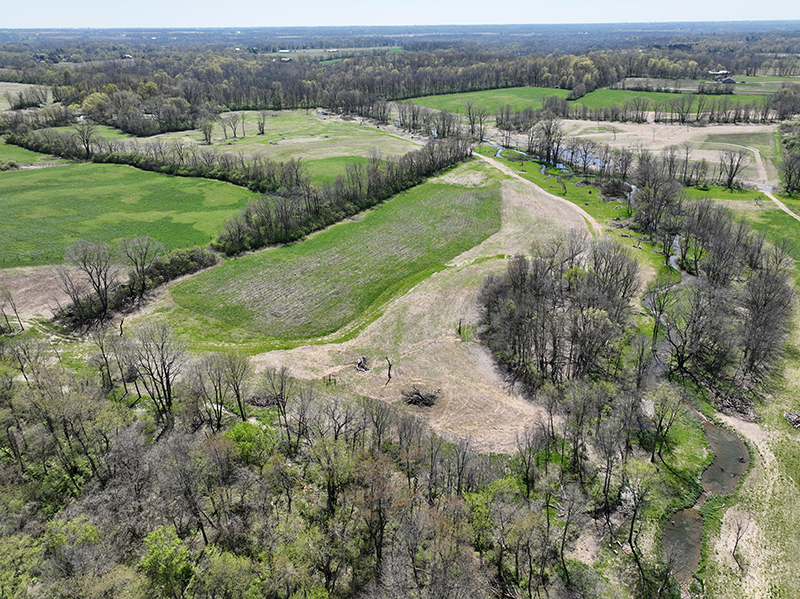
Cecilia: It really lets the team focus on the art of the construction as opposed to the details. They’re working on creating a bigger picture and less focused on, “Do I have the right elevation here? Is this right here?” I think together they are able to create a more complete and holistic picture of what the design is supposed to be.
We are also talking about nature-based solutions, which require time to establish. We cannot dismiss the natural elements and vulnerability of these projects. [With design-bid-build], a construction firm could build the system, get the plants in the ground, get project acceptance, and then walk away without any real concern about the survivability of the plants, and we know those plants are doing a lot of the work in these systems. With the nature-based approach, we have to give the systems time to establish so they can function as they were designed to, and I think that design-build helps with that.
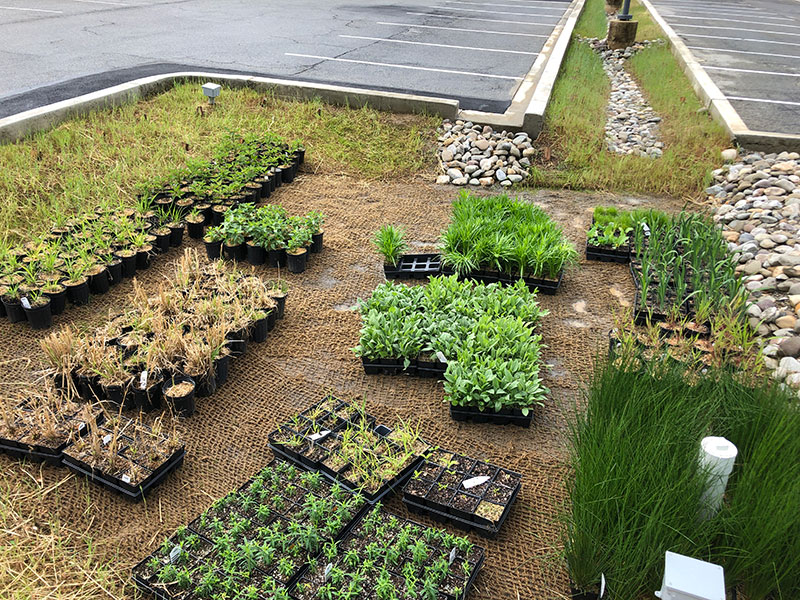
When you first started using design-build or you were first contemplating using this approach, did you have any reservations about it?
Cecilia: I have been with the District for seven years now. I walked into an area where we were allowed to use a design-build delivery method, which isn’t always the case in other jurisdictions. DOEE initially moved to a design-build approach for cost savings reasons. The caveat being with stream projects, many of which are on federal land in the District, and our federal partners wanting to see more detailed designs to help facilitate the NEPA process.
The design-build delivery method is commonly heralded for its ability to shrink schedules and potentially budgets. What about the outcomes? I think one of you may have touched on this, but how do you think the design-build delivery method impacts the final solution or product or deliverable?
Amelia: I think it gives you a more cohesive product. I like that everyone has buy-in from the get-go. We monitor our sites for 10 years afterwards, so that part of the work is on us, but with the design and construction, it’s great to have that cohesive approach between our designers and the construction firms. I think that’s just always going to lead to a better product.

Cecilia: I agree. We talked about flexibility and adaptability. I’d also add streamlined communication and decision making. That’s a big one. With design-build, I’m not having to coordinate across multiple firms. I have a prime that’s working to do that, so from a client management perspective, I’m dealing with one individual. I might deal with others at different stages, but I ultimately have that sole point of contact, which I think helps with just everything: organization, continuity, cohesiveness, and greater accountability. I feel that the design-build process is more collaborative, flexible and accountable, so we get higher quality products that meet our overall project objectives.
… the community just feels a little bit more connected, both to the project team and the overall asset that we’re building.
I also feel it creates a sense of partnership with stakeholders when, for example, in our public meetings, they’re getting to meet representatives of the construction team who they can approach directly with any concerns about the effort. Maintenance is always a concern for the public and learning that the vendor is responsible for the first year or so of maintenance helps build confidence with the surrounding community Ultimately, the community just feels a little bit more connected, both to the project team and the overall asset that we’re building.
You mentioned greater accountability. Do you think that risk has something to do with that? From what I understand, in a design-build delivery method, the designer builder, as opposed to the project owner, really carries a lot of that risk if things go awry.
Cecilia: I do, and I’m going to give you an example. As part of the Green Infrastructure Leadership Exchange, I once sat in on a contracting working group with other jurisdictions from around the country and heard that many municipalities do not have a design-build option available to them. In one urban jurisdiction where they are not allowed to use a design-build approach, they often find that once the project is fully designed, the designer is gone, and someone else comes in to construct it. Because it is an ultra-urban environment, there might be necessary changes, but there might not be that level of buy-in to the original design. One of the things this jurisdiction communicated to us was that they don’t even ask their construction subs to plant these systems anymore because they were just planting, walking away, and taking a hit on the plant replacement costs. There was no level of buy-in in terms of the survivability of the vegetation, which, as I mentioned, is so important to the success of these systems. They actually ended up removing the task from their construction contracts and moving it into their maintenance contracts because there’s going to be a level of accountability with that vendor. I didn’t realize how fortunate we were to be able to take a design-build approach until I started talking to some other jurisdictions where this procurement option isn’t available to them.
I didn’t realize how fortunate we were to be able to take a design-build approach until I started talking to some other jurisdictions where this procurement option isn’t available to them.
How does the design-build project delivery method compare to design-bid-build when it comes to you and your staff, in terms of your time, stress level, headaches, etc.
Amelia: We have a timeframe for project completion, so working with timelines and meeting deadlines is very important for us. I found design-bid-build pretty stressful because of the long pauses in, okay, done this step, and now we have to wait and bid this part out, and we have to wait and get bids, and now this has to happen. I was kind of biting my nails the whole time, wondering, “Are we going to make these deadlines?”
There are also the everyday parts of the work that are temporal: trees have to be cut down during a particular season, and we can only do in-stream work during certain months of the year. Having to meet all of those requirements, in addition to the timeline that we have for construction, was very stressful for me. That’s one reason I really came to appreciate the design-build approach, because it does streamline all of those tasks from the beginning, and you don’t have those pauses and interruptions. That is a deal breaker for sure. That is what made me say, “That’s why I like these projects so much more!”
Cecilia: I definitely echo that about the timing and the interruption. Say, for example, you take a design-bid-build approach, because you do not yet have the funding for construction. You may end up in a situation where you have a fully designed project that doesn’t get implemented for five to 10 years. We find that in that five to 10 year period, there can be new approaches, new regulations, all of these details that weren’t addressed in the original designs.
I definitely think whenever there’s this potential for a lag, then you’re really increasing the work on the project manager side of things. Are you coordinating with a firm you haven’t engaged with in five years? To what degree did they need to be responsive to you? Also, design-build means one procurement package versus a design-bid-build approach which requires navigating through procurement at least twice! In the District, procurement can be a time-consuming process, and for good reason! There are lots of rules and regulations in place to ensure that District dollars are being allocated fairly and appropriately.
Let’s talk about community stakeholder engagement. Whether your project is in an urban or rural area, you’re going to have stakeholders, or people who have deep connections to the place that’s being impacted. The input of those people can be critical to the long-term success or perhaps even viability of the project. How do you handle that in a design-build situation? What happens if community input reveals something that changes the nature of the design and impacts the contracted budget or schedule?
Amelia: We haven’t had any big issues like that. Something else comes to mind when it comes to stakeholders. We have an Interagency Review Team (IRT) that oversees and approves all of our work. It consists of the U.S. Army Corps of Engineers, U.S. Fish and Wildlife, Ohio EPA, U.S. EPA, and state and federal other agencies They oversee our designs from beginning to end, and they approve our funding for construction. We have 30%, 60%, and 90% meetings with the IRT, and they give us comments. Another reason why I like design-build is that we can work with our designers to incorporate this feedback if needed. Luckily, there hasn’t been anything significant that has caused a big schedule or a budget change, but I like the fact that as we get IRT feedback, we are able to incorporate that with our designer, and our designer can check that with the construction firm, and they can have that dialogue. By the time we get to approval, everything is dialed in, everybody is on the same page, and we can just construct the project.
Cecilia: We try very hard to get folks engaged in these projects, and we have a lot of stakeholder involvement. I appreciate the design-build approach and having one cohesive project team because the designer and the construction foreman are participating in our public meetings. They are being seen by our stakeholders, and they are hearing their concerns directly. This has allowed for flexibility and adaptability. For example, we may have put together a lengthy Maintenance of Traffic plan that has been approved by our Department of Transportation, but then we hear from stakeholders that kids are going to be dropped off at the rec center or camp (project site) at a certain time of day and there are concerns about safety. Being able to say, “We can adjust. We hear you and we can easily pause dumping during this timeframe for safety reasons” is powerful. It is also just a faster process. We don’t have to go through multiple chains of command. It’s a discussion and adjustment.
A great example is the Woody Ward Recreation Center retrofit project. Through community engagement efforts, we learned of a nuisance flooding situation that the neighborhood was regularly experiencing. Through the design-build process, we were able to identify additional funds to expand our efforts, increase stormwater capture, and address the community’s nuisance flooding issue—a win for all!
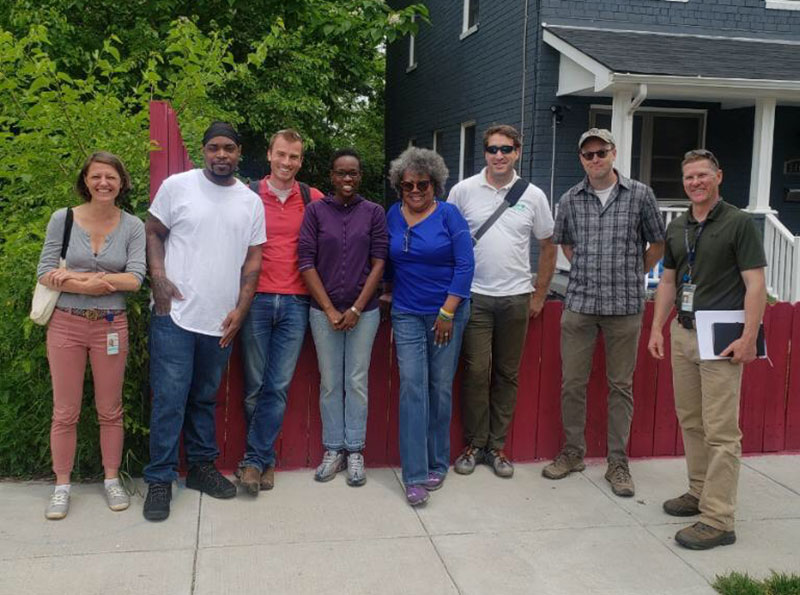
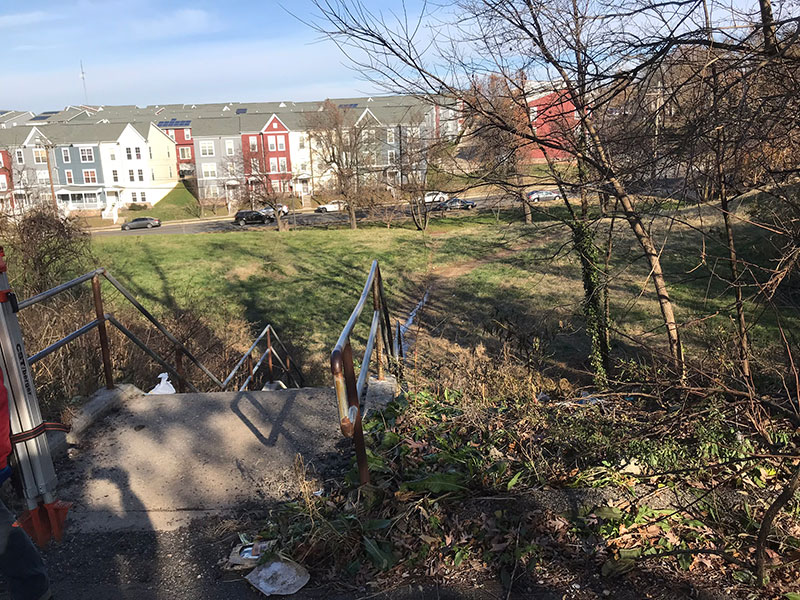

For our design-bid-build projects, we are now adding participation in the bid period for construction. This way, the firm that has gone through design and public engagement is supporting us in the solicitation process, and most importantly, in the price negotiations during the competitive process. They are able to answer questions about the design and possibly negotiate some of those bids. This keeps the designer more engaged throughout construction and provides another level of oversight if and when there are design modifications. It also helps us ensure that the project is built to the designs and original objectives of the effort.
I’m hearing from both of you that there is great value to having the designer involved in the construction phase and the contractor involved in the design phase. Can you share any anecdotes about ways in which the design-build project delivery method really saved the day for you?
Cecilia: In the District, there are all sorts of utilities and pipes that show up on maps but often cannot be located in the field. Or you may have the opposite situation: you had no underground utilities or pipes that you were aware of until you started digging. With design-build, you have the ability to adapt quickly to the reality of the situation.
Amelia: I don’t have any big anecdotes, but small things happen all the time on our projects where we are able to preserve the natural resources that are on the site while restoring and building bigger components. It’s small things, like, “Oh, there is a really nice, big tree here. On the design, the stream went right through it, but hey… the designer on site. We can make this little change, they can approve it, and we can work around the tree.”
As we discussed earlier, there are many agencies and organizations that are not able to use the design-build model. Tell me more about what you hear from your peers in other regions about barriers to design-build?
Cecilia: At the Green Infrastructure Leadership Exchange I mentioned earlier, I learned that many municipalities that cannot use design-build are really grappling with how to get designs constructed the way they were intended. The designers are so far removed from the actual end product in that situation, or the construction firms are very focused on project wrap-up and demobilization, and not on vegetative establishment. They are frustrated at the lack of continuity, and then they’re forced into low bid situations where they are not really getting the product that they paid for through their design process. Sitting in that working group, I realized how much more challenging things would be for us if the design-build option were to be taken away.
In addition to appreciating the integration of design and construction in a design-build project, I would add maintenance. I’ve had several projects that have run into issues post-construction where the project has been accepted, but through maintenance, we really haven’t got to a full establishment. Being able to tap the designer, and say, “I’m not seeing what I expected to see with this system,” and having that individual come out and troubleshoot with me and make sure we don’t have a flaw in design or oversight in construction is very helpful—something that can be missed in the single project acceptance walkthrough at the end of construction. I still have my one point of contact, and I know that individual is personally invested in the success of the project. I don’t feel like I’m nagging them or having to awkwardly tell them, “Hey, you need to help me with this.” If it was a design-bid-build project designed five years ago, who knows where that designer is today?
Amelia, what about you? Do you hear a lot about others who wish they could take advantage of this contracting mechanism or project delivery method and can’t?
Amelia: I feel very fortunate that The Nature Conservancy gives us the leeway to do the kind of contracting that we find appropriate and that allows us to work efficiently.
Cecilia: [The barrier to design-build] is often a procurement regulation. Another challenge with design-bid-build in municipalities is that they are often driven by low-bid requirements. We are always looking for the best deal for the District, but we want folks that have the experience, expertise, and knowledge to get these projects done well. We are still able to also avoid a low bid scenario by requiring a lot of experience and expertise. It is not necessarily true that in a design-bid-build approach we would be pushed into a low-bid situation, but I do think it is more of a vulnerability in that case: You have 100% permitted plans; these are the firms that are qualified; go forth and build it. But we all know that there are nuances to this type of work.
